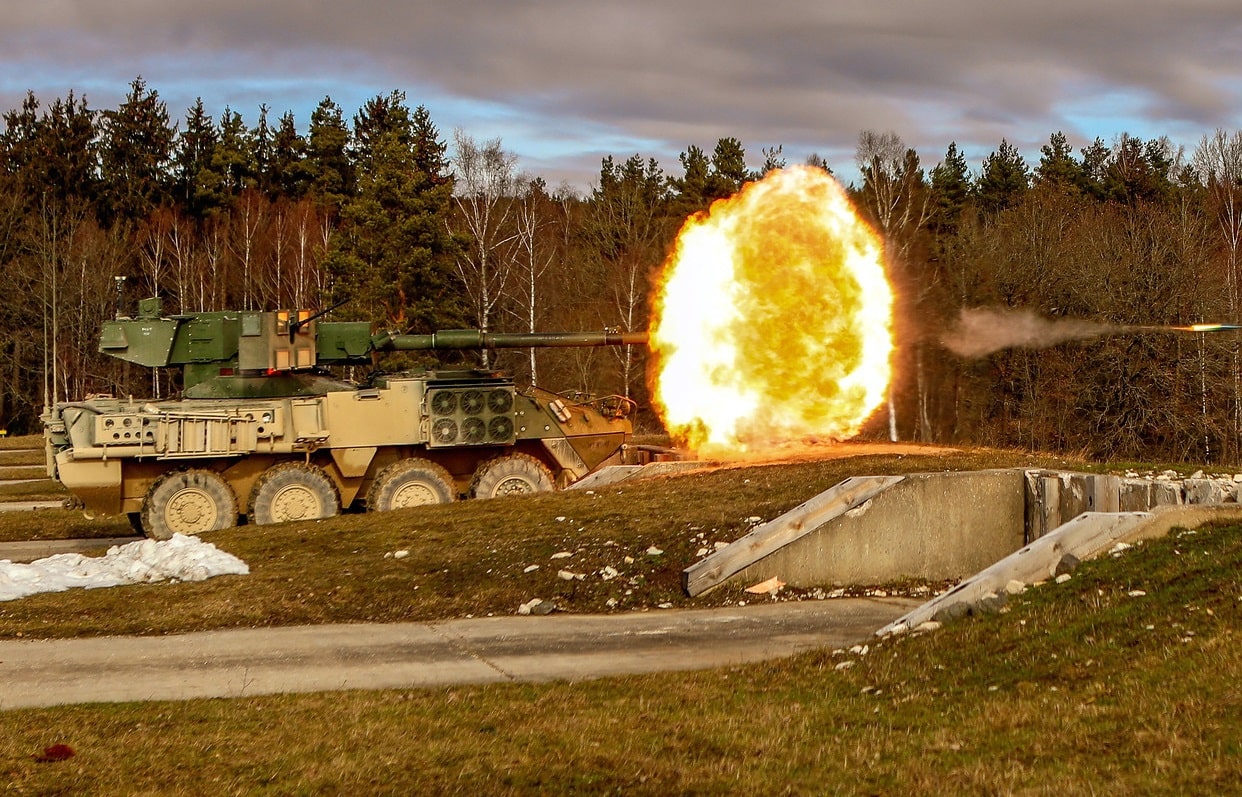Destroying drones with Hellfire missiles, moving infantry to “close-with-an-enemy” at high speeds, incinerating helicopters with laser weapons, and firing air-burst 30mm proximity rounds at enemy troops and armored vehicles are just a few of the more recent missions U.S. Army Stryker vehicles can perform.
Stryker: A Powerful Weapon of War
The 8X8 wheeled vehicle infantry carrier has proven itself in combat for several decades and evolved into multiple variants and an increasingly lethal combat platform.
While there are many distinguishing elements of the Stryker vehicle, one key attribute is mobility.
As a wheeled vehicle, the Stryker can move at faster speeds than tracked platforms and support dismounted infantry moving to contact with an enemy. The Stryker’s mobility, for example, figured prominently in a cross-continental European convoy led by U.S. Army Europe in 2015 called the Dragoon Ride.
The concept of the convoy was to demonstrate cross-continental deployability and interoperability with key Eastern European allies close to the Russian border. As a fast speed wheeled infantry carrier, the Stryker was an optimal platform for this kind of mission.
The Upgrades Keep Coming
Over the years, the U.S. Army has integrated a progressive series of substantial upgrades to the Stryker vehicle to meet emerging threats. During the war in Iraq and Afghanistan, for example, Strykers were engineered, built, and fast-tracked with what’s called a “double-V” hull for deflecting IED blast debris and protecting soldiers riding in Strykers from roadside bombs.
In more recent years, the Stryker platform has been armed with what the Army calls Maneuver SHORAD, for Short Range Air Defense. Recognizing that the Army was shifting from counterinsurgency to a great-power warfare strategic posture, the service added an integrated counter-air capability to the Stryker and armed it with drone-and-helicopter-killing Stinger and Hellfire missiles.
Building upon SHORAD, the Army has since further evolved Stryker lethality and armed the vehicle with an air-burst capable 30mm cannon as well as laser weapons.
Laser-Armed Strykers
Given these successful modernization efforts, the Army plans to deploy Strykers for several decades into the future and add more innovations as they become available.
Seeking to anticipate this, Stryker maker General Dynamics Land Systems recently unveiled its StrykerX demonstrator vehicle, adding several new technologies.
The StrykerX is a new AI-enabled demonstrator vehicle GDLS is offering to the Army build with a hybrid-drive-enabled ability to conduct silent watch and reconnaissance missions, launch and recover drones, and integrate the latest increment of SHORAD, which arms the platform with 50kw laser weapons.
This not only introduces new prospects for precision attack upon enemy drones but also introduces an ability to attack and defend at the speed of light. Lasers, if properly and fully integrated with the requisite mobile electrical power, are inherently scalable, meaning they can be adjusted to fully incinerate and destroy enemy targets or merely disable functionality.
Stryker Heads Into the Future
Army Strykers armed with lasers and other air-defense weapons are causing the Army to rethink its armored vehicle formations and rapidly integrate methods of incorporating unmanned systems – ground and air drones – into armored vehicle maneuver.
The presence of new weapons of this kind might enable mobile units to hit enemies faster, add precision, and in some cases lower collateral damage.
In a heavily populated urban area, for instance, firing a missile interceptor might cause a larger, more dangerous explosion; firing a laser that slowly burns a hole through the metal of an enemy air target can decrease fragmentation and tailor the timing of when an enemy asset is ultimately disabled. As part of this attack envelope, lasers are scalable.
Several beams can be merged for a stronger impact. The beam’s strength can be adjusted, enabling attackers with a range of options including destroying or merely disabling a target. So while the initial weapon is slated as 50kw, the power will likely go up as technology allows.
Most recently, the Army Stryker has demonstrated a new ability to destroy incoming mortar and artillery fire with a 50kw laser weapon called High Energy Laser weapon by Raytheon.
Kris Osborn is the Military Affairs Editor of 19FortyFive and President of Warrior Maven – Center for Military Modernization. Osborn previously served at the Pentagon as a Highly Qualified Expert with the Office of the Assistant Secretary of the Army—Acquisition, Logistics & Technology. Osborn has also worked as an anchor and on-air military specialist at national TV networks. He has appeared as a guest military expert on Fox News, MSNBC, The Military Channel, and The History Channel. He also has a Masters Degree in Comparative Literature from Columbia University.

